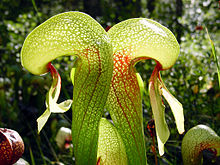| Cobra lily | |
|---|---|

| |
| Darlingtonia's translucent leaves confuse insects trying to escape. | |

| |
| Darlingtonia State Natural Site, Florence, Oregon. | |
| Scientific classification | |
| Kingdom: | Plantae |
| Clade: | Tracheophytes |
| Clade: | Angiosperms |
| Clade: | Eudicots |
| Clade: | Asterids |
| Order: | Ericales |
| Family: | Sarraceniaceae |
| Genus: | Darlingtonia Torr. (1853) |
| Species: | D. californica
|
| Binomial name | |
| Darlingtonia californica Torr.
| |

| |
| Darlingtonia distribution | |
| Synonyms | |
| |
Darlingtonia californica /dɑːrlɪŋˈtoʊniə kælɪˈfɔːrnɪkə/—also called the California pitcher plant, the Oregon pitcher plant, cobra lily or cobra plant—is a species of carnivorous plant in the new world pitcher plant family, Sarraceniaceae. It is the sole species within its monotypic genus, Darlingtonia. The cobra lily is native to Northern California and Oregon, in the western United States, where the climate—while typically thought of as cool and humid—may be quite arid for many months of the year, more so than many carnivorous or pitcher plant genera could feasibly survive (such as Heliamphora, Nepenthes or Sarracenia). However, the cobra lily has evolved into life along the West Coast and in the lower Pacific Northwest through its carnivorous adaptions, where it may be found near bogs, vernal pools, on forested rocky slopes (near snowmelt, especially), creeks, or near seeps with cold running water, usually on serpentine soils. It has even been observed growing in drainage ditches or on the sides of roads. Despite being fairly commonly cultivated, Darlingtonia is designated as uncommon due to its rarity in the field.[2]
The name "cobra lily" stems from the resemblance of its tubular leaves to a rearing cobra, complete with a forked leaf – ranging from yellow to purplish-green – that resemble fangs or a serpent's tongue.
The plant was discovered during the Wilkes Expedition of 1841 by botanist William D. Brackenridge at Mount Shasta, Northern California. In 1853, it was described by John Torrey, naming the genus Darlingtonia after Philadelphian botanist William Darlington (1782–1863).
Cultivation in the UK has gained the plant the Royal Horticultural Society's Award of Garden Merit.[3][4]
- ^ Schnell, D.; Catling, P.; Folkerts, G.; Frost, C.; Gardner, R.; et al. (2000). "Darlingtonia californica". IUCN Red List of Threatened Species. 2000: e.T39714A10259059. doi:10.2305/IUCN.UK.2000.RLTS.T39714A10259059.en. Retrieved 28 May 2022.
- ^ The Jepson Herbarium – University of California, Berkeley
- ^ "RHS Plantfinder – Darlingtonia californica". Retrieved 6 February 2018.
- ^ "AGM Plants – Ornamental" (PDF). Royal Horticultural Society. July 2017. p. 16. Retrieved 24 January 2018.
